|
   |
|
Page 4 |
Newsletter 114, Autumn 2016 © Hampshire Mills
Group |
Skerries Mill and Tacumshane Windmill,
Ireland
Ruth Andrews
|
Driving up the coast north of
Dublin in search of rock formations, Keith and I
were surprised to encounter brown signs directing us
to ‘Skerries Mills’ – no mention in any
guidebooks, of course. The signs mysteriously
finished well short of Skerries town, so we set off
to find the rocks on the beach, from where we were
pleased to see two distant windmills in the middle
of the built-up area. |
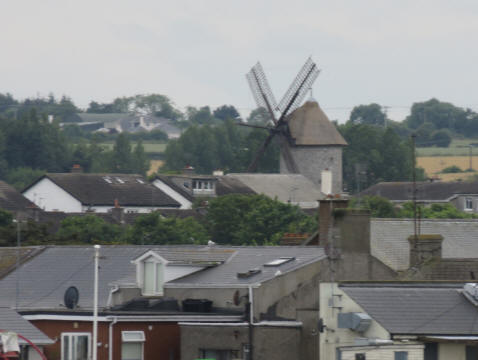
The Mills seen from the beach |
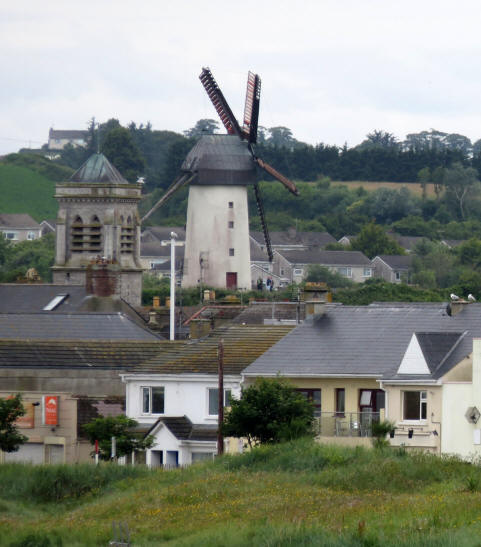 |
|
Imagine our surprise on reaching them (by trial and
error until I spotted ‘Miller’s Lane’) to find a
5-sail tower mill, a smaller 4-sail thatched tower
mill, and a 4-storey watermill, all on the same
site. The watermill and smaller windmill are both
open to the public and on the day we were there we
had an eloquent and knowledgeable guide called
(inevitably) Paddy.
The watermill is first mentioned in mid-17th and
early 18th century maps and documents. During the
mid-19th century it supplied flour, meal, and bread
to the Balrothery Union Workhouse. Two of the
original four coke-fired ovens are in the reception
area. Milling probably ceased around 1921 and the
bakery finally closed in 1986 following a fire. The
site was purchased by Dublin County Council in 1989
and extensive refurbishment was carried out before
the complex was opened to the public in June 1999.
The mill has one set of English Grey (Derbyshire
Peak) stones without dressing used for shelling or
bruising oats, and two sets of French burr, and it
is powered by a pitch-back metal wheel with a wooden
flume (launder). The buildings and a covered area
outside display a wide selection of cleaning and
processing machines, including a neat little
plansifter with leather straps on the dressing floor
and a bread-slicing machine.
|
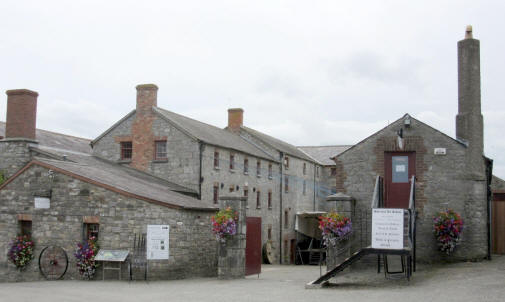 |
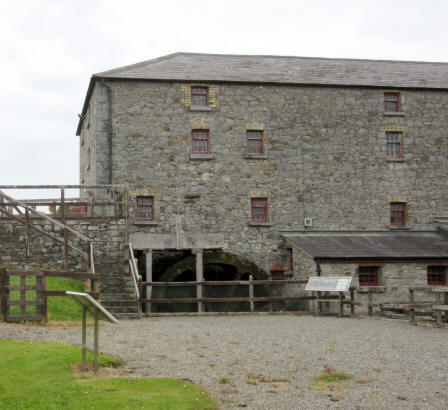 |
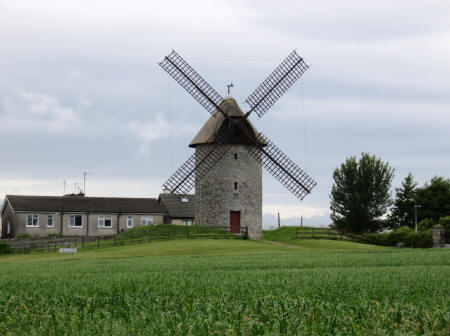 |
The 4-sail thatched windmill
has canvas sails and one pair of stones. The cap
rests on bearings and is designed to be ‘luffed’
(turned to wind) internally by a hand lever but in
practice (according to Paddy) is heaved round with
chains by several stalwart volunteers. The crop in
front of the mill is oats and they harvest it ready
for a steam threshing day each autumn.
|
|
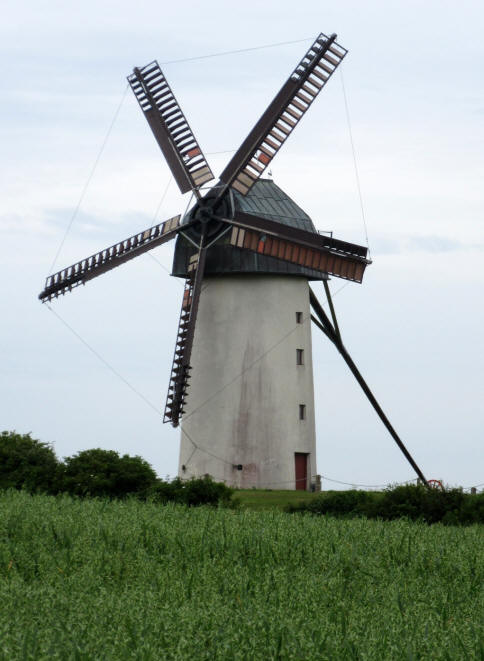 |
The Great Windmill of Skerries was built with 4
sails but rebuilt with 5 sails following a fire in
about 1844. The sails are an early version of
Cubitt’s patent. They appear to have no ‘spider’,
so each set of shutters must be operated
individually from ground level. (I don’t know much
about this so could someone please explain the
details of the sails shown below.) There are two
sets of millstones. The cap is turned by pulling
round the braced tailpole supported by the red wheel
(just visible over the bushes).
This mill is not generally open
to the public.
I
know it is a long way to Dublin (but not as far as
Tipperary!), but this site really is worth a visit.
We would like to publicly thank ‘Paddy’ for stepping
off script and welcoming us to the mills.
The mills are open
daily; for details see
www.skerriesmills.ie .
. |
|
Unlike Skerries Mills, we were aware of
Tacumshane Windmill near Rosslare in County
Wexford because it featured in an advert for
Millstones Bar and Restaurant. The key is available
from the bar, and after exploring the mill we
indulged ourselves further with an excellent meal.
It is a small tower mill with two sets of large but
incomplete stones. It was probably built in 1846,
and used until at least 1908 when it was
re-thatched. Between 1908 and 1930 it became
disused and fell into disrepair. Garry Murphy
acquired it in 1930 and replaced the damaged parts
using iron machinery from the mill at Ballyfane
nearby, which was destroyed in a great storm in
1905. The mill functioned again until 1936, when a
diesel engine was installed in the grain store
beside the mill where it drove a pair of small
millstones for 25 years until 1961. (The diesel and
grain store no longer exist.) The mill was placed
in the care of the Board of Works in 1948 and major
repairs were undertaken in 1952.
|
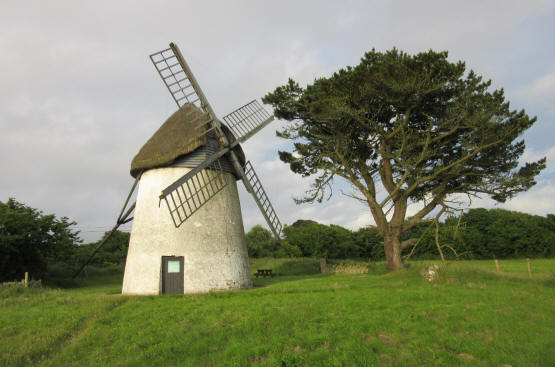 |
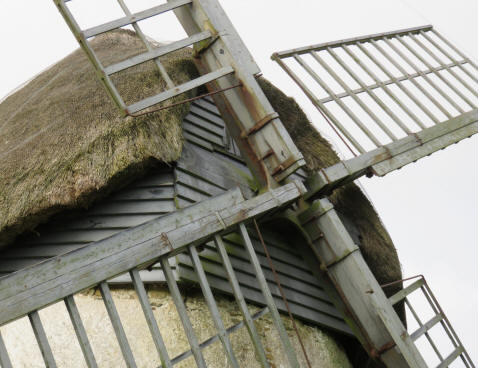 |
|
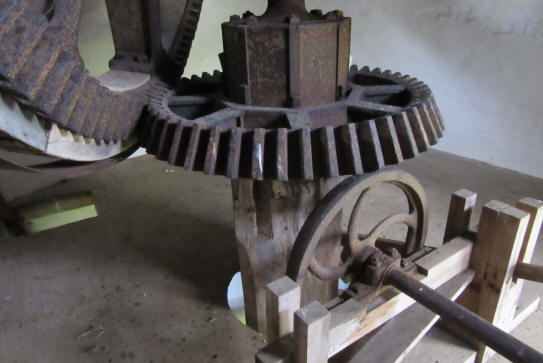
The replacement ironwork makes
an uncomfortable fit with the older wooden upright
shaft. The metal rod at the base of the shaft
(right) is apparently ready to bore a hole in the
timber beneath it. The sack hoist drive (above)
from the bevel gear appears to have relied on
friction metal-on-metal.
|
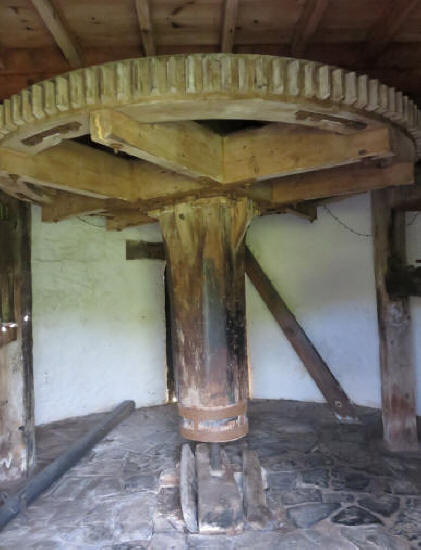 |
|
   |
|
|
